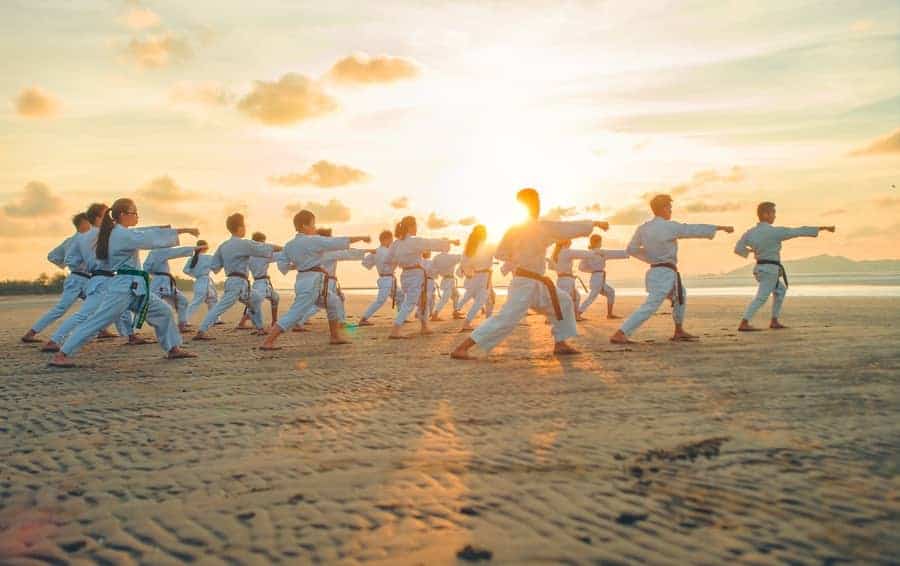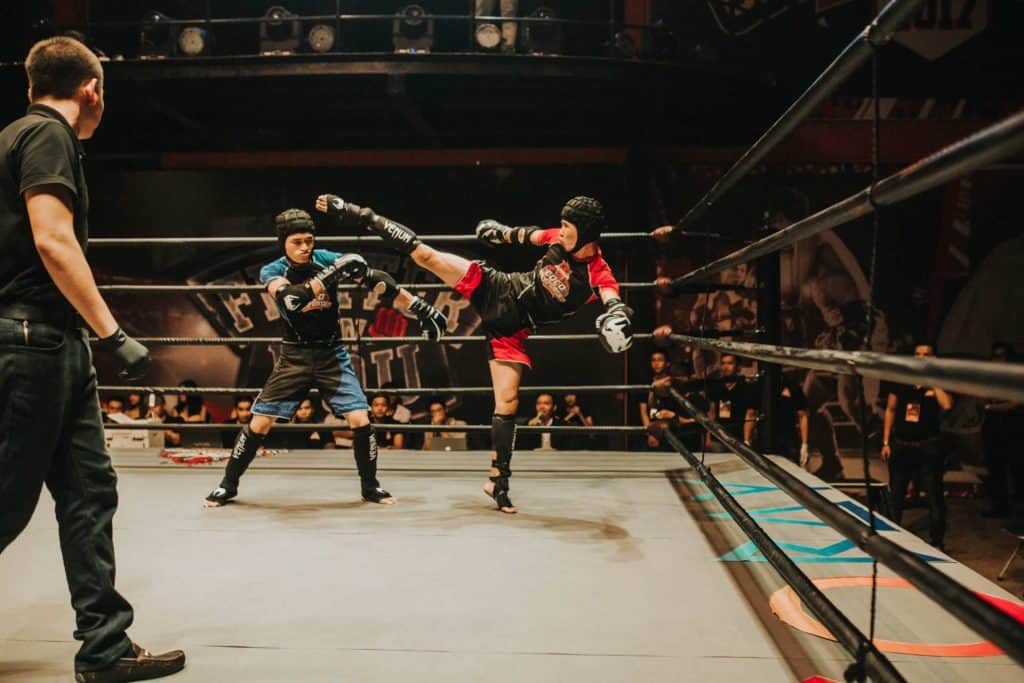MMA, or mixed martial arts, is one of the most popular sports today. Many people extensively follow the fighters, the events, their lives and their trainings, just to see them face each other in a full arena while being watched by millions of people around the globe. But despite being so popular, MMA is pretty controversial and it’s not just the brutality of the fights, which you probably thought of first. Namely, there is a lot of debate whether the sport called mixed martial arts is actually a martial art, or a regular combat sport!
MMA is not a martial art in the classical sense, but rather a combat sport. Despite being consisted of different martial arts, MMA itself has no elements that make martial arts what they are. MMA is focused on combat, without any of the philosophical elements that are a necessary prerequisite for a discipline to be described as a martial art.
That was a somewhat superficial answer. So, if you ever wondered if MMA is a martial art or a combat sport, you’ve come to the right place because we’re going to answer that question more precisely for you in today’s article.
What Is Considered a Martial Art?
The term “martial art”, according to Wikipedia, encompasses a large number of codified systems and traditions practised for different reasons. The term itself is a reference to the Ancient Roman god of war, Mars, with the Latin phrase (artes martiales) literally meaning “arts of Mars”. Today, the term is mostly associated with Oriental arts, but interestingly enough, it was firs used to describe European fighting styles as early as the 1550s.
On the other hand, the term “combat sport” refers to a large number of competitive contact sports that usually involve one-on-one combat between fighters. This term is newer than the former, but the process of systematizing competitive combat sports has been going on since the Middle Ages.
Martial Arts
As the name suggests, martial arts are a form of art. They are a very specific set of skills that can be applied to a lot of aspects of our lives, not just combat. These aspects include, but are not limited to self-defence, military and law enforcement, spiritual, as well as physical and mental development, life philosophies and the preservation of one’s cultural and historical heritage.
Martial arts are usually very old and have long-lasting traditions. The system of a martial art is built throughout centuries, with newer practitioners upgrading and enriching the firmly founded traditions and philosophies.
A martial art can have several different schools of thought; each school teaches the same art, the fundamentals, but has a different approach to some aspects. Such an approach to martial arts and the fact that most modern martial arts come from East Asia, enabled these styles to be intertwined with philosophy, which is why most martial arts have a transcendental part of the teaching, along with the practical one.

Martial arts can be divided based on several criteria. The simplest distinction is between traditional (or historical) martial arts (such as folk wrestling) and modern martial arts (such as hybrid martial arts). This distinction follows the historical development and shows when a particular martial art was established. It is overly simplistic and doesn’t reveal much about the essential aspects of each art.
The second – and more precise – distinction is based on the technical focus of the martial art. Here, we can divide them into unarmed and armed martial arts; this distinction isn’t firm, as some unarmed martial arts have armed techniques and vice versa, but it is made based on the focus of each martial art’s teachings.
Unarmed arts are further divided by the predominating type of combat into striking- (p.e. karate, taekwondo, Muay Thai) and grappling-based arts (p.e. judo, wrestling). They can also be distinguished as stand-up and ground fighting arts.
Armed martial arts are, of course, further divided based on the type of weapon used. Most of them use a wide variety of melee weapons and can thus be considered as mixed, but some one-weapon martial arts are also included in this category, such as the Japanese art of kendo.
A third distinction is based on the intent or application of the martial arts. Here, we can distinguish combat-oriented martial arts (whose main focus is contact fighting), health-oriented martial arts (whose main focus is based on combining Asian medicine and martial arts techniques) and spirituality-oriented martial arts (whose main focus lies on developing the practitioner’s spiritual qualities).
There is also a fourth distinction, but it is not as widespread; in the Chinese tradition of martial arts, they can be divided into external and internal, which is something we’ve already discussed in a [previous article].
So, to conclude, martial arts are defined by their complexity. They have a much wider scope of possible applications and are not primarily combat-oriented (some do not have combat elements at all!) and it is exactly that, the profoundness and the philosophical foundations, that makes them so special and unique.
Combat Sports
Unlike martial arts, combat sports are primarily a sporting (physical) activity focused on – in most cases – full-contact one-on-one combat. It is a competitive discipline where fighters face each other in an arena and fight adhering to a pre-existing set of combat rules. The main goal of combat sports is to win, i.e. defeat your opponent and win in a fight. This can be achieved by knocking your opponent out or, if case that does not happen, having more points awarded to you by a panel of (ringside) judges.

Unlike martial arts, combat sports were never envisioned as a form of art, as something more than just combat. We’re not implying that combat sports are just brute force – they’re not – but they don’t actually have that profound, philosophical component that is typical for martial arts in general. As stated before, martial arts are also a form of philosophy and combat sports aren’t. They’re a competition where the goal is to win. In martial arts, the goal is to deepen yourself and elevate your skills and views. So, the fundamental difference lies with the approach – although similar in one aspect, both of these just come from a different place and that’s it.
Some combat sports can also be described as martial arts and vice versa, but those are rare examples. Much debate has been led about the nature of both wrestling and boxing; these two disciplines have such long traditions that they can easily be considered martial arts, but they’ve also gone through so many changes in recent times that the essential aspects of martial arts have mostly disappeared, especially in boxing. While we could state that modern wrestling does retain a lot of traditional elements and can thus be described as a martial art, modern boxing has changed radically so it is very difficult to describe it as anything other than a combat sport. Classical boxing might have been a martial art, but modern boxing didn’t preserve those elements and is closer to modern combat sports.
As with martial arts, combat sports can be divided into unarmed and armed ones, based on the usage of different weaponry.
Is MMA a Martial Art?
So, where does MMA figure in all of this? Considering the nature of MMA, we have a very interesting situation. As the name states, MMA is a combination of different martial arts and it is a fact that, when arts used in MMA are concerned, more could be described as martial arts than not. And yet, despite combining martial arts, MMA is an individual unit, different from the sum of its parts.
And exactly because of that – we can conclude that MMA is not a martial art in the classical sense, but rather a combat sport. Despite using martial arts, MMA itself has no elements that make martial arts what they are. MMA is focused on combat, on winning, on fighting, without any of the philosophical elements that are a necessary prerequisite for a discipline to be described as a martial art.
This, of course, doesn’t mean MMA is worth less than martial arts. It’s really just a matter of approach. Both MMA and martial arts have something special, something specific that makes them what they are and it is ultimately up to you which one you’ll choose.
After understanding the intricacies of MMA being a martial art or combat sport, you might be eager to practice and hone your skills. In order to ensure you excel in your training, choosing the right wear can make a significant difference in both performance and comfort during your sessions.
Check out our comprehensive guide on finding the best MMA shorts, which can elevate your MMA performance while providing maximum comfort for an enjoyable training experience.
That covers our topic of the day. If you are interested in MMA, be sure to check out our series of articles on Mixed Martial Arts. Thank you for reading it and stay tuned for more of the same!

